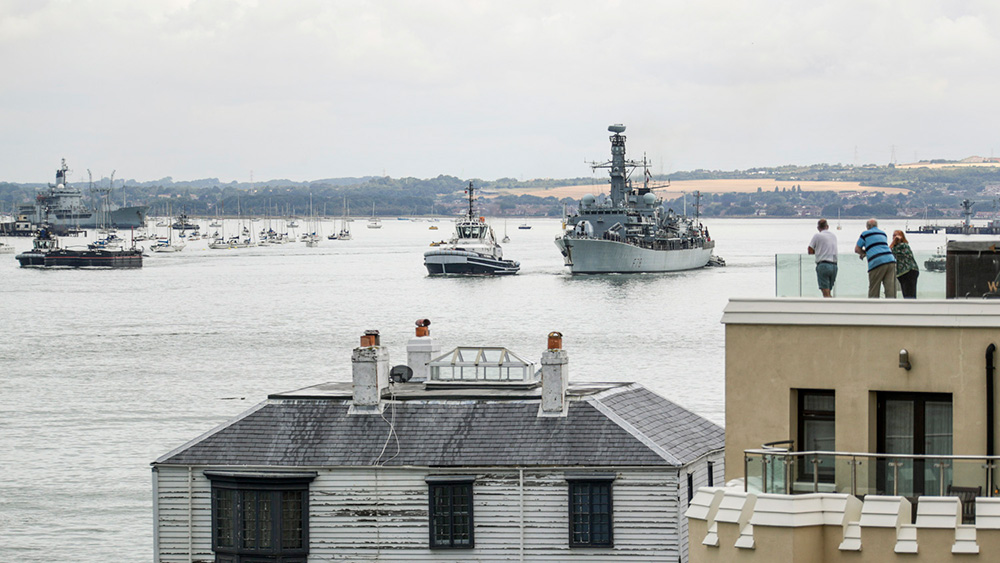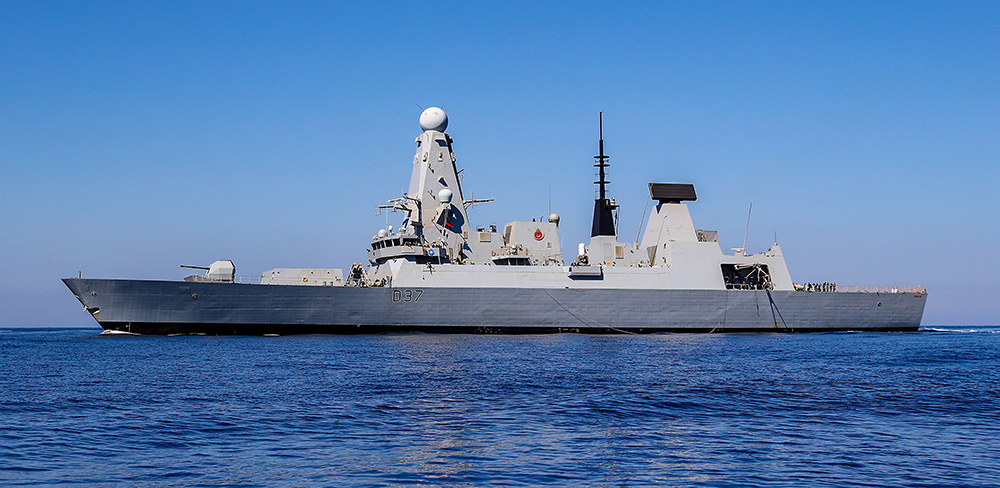SEA
Explainer: The Royal Navy’s role in the Persian Gulf
The Gulf region has become a flashpoint with Iranian forces threatening western vessels travelling through the narrow Strait of Hormuz. For the Royal Navy, which recently re-established a permanent base in the region, it has highlighted a worrying lack of vessels and a possible over-reliance on international support, as Grant Turnbull explains.
The Gulf region has become a flashpoint with Iranian forces threatening western vessels travelling through the Strait of Hormuz. For the Royal Navy it has highlighted a lack of vessels and a possible over-reliance on international support, as Grant Turnbull explains.

// The Type 23 frigates are at the heart of the Royal Navy's presence in the Middle East. Image: Crown Copyright / MOD
What is the Royal Navy’s historic role in the Persian Gulf?
The Royal Navy’s involvement in the Persian Gulf can be traced back nearly two centuries when the senior service led efforts to control piracy, especially if it was interrupting merchant vessels coming to and from Britain's eastern empire, notably India. British officials forged close ties with key figures in the region and by 1932 had agreed with Bahraini leaders to build a permanent naval base at the port of Mina Salman, known as HMS Jufair, which was officially established in 1935.
The decline of the British Empire over the 20th century eventually led the UK Government to abandon much of its commitments ‘East of Suez’, including HMS Jufair in 1971.
Did the Royal Navy completely abandon the Gulf after 1971?
Not quite. After only nine years the Royal Navy returned to the Gulf as part of the Armilla Patrol and has maintained a permanent presence ever since. Set up in September 1980, the Armilla Patrol's mission was to protect British merchant shipping passing through the Persian Gulf during the Iran-Iraq war. The two warring nations would frequently attack each other's oil tankers and foreign vessels would get caught in the crossfire prompting the US Navy to also intervene. This period is commonly known as the Tanker War.
The Armilla Patrol was also used during and after both Gulf Wars in 1990 and 2003, respectively. In June 2011, the Armilla Patrol evolved into Operation Kipion, which now represents the Royal Navy's current security mission in the region and has a wider remit to include the Suez Canal, Strait of Hormuz and piracy in the Indian Ocean.
In 2014, the UK announced plans to re-establish a permanent Royal Navy base in the Gulf, which some commentators and analysts described as a return to Britain’s global ‘East of Suez’ role. This would see the reopening of HMS Jufair (also known as UK Mina Salman Support Facility - MSSF) in Bahrain, which had been used by the US Navy since 1971.
UK MSSF was officially opened in April 2018.

UK Mina Salman Support Facility, or HMS Jufair, was officially reopened in 2018 as a permanent base for the Royal Navy in the Middle East. Image: Crown Copyright / MOD
What assets has the Royal Navy deployed to the Gulf?
For the first Armilla Patrol, the Royal Navy deployed the Type 42 destroyer HMS Coventry. From then on the service would typically deploy either a frigate or a destroyer along with a Royal Fleet Auxiliary support ship. During times of conflict, including both Gulf Wars, the Royal Navy would bolster this presence significantly to include larger Task Forces with assets such as aircraft carriers.
The Royal Navy also permanently stations four minesweeper vessels (two Hunt-class and two Sandown-class vessels) in the Gulf, ensuring key waterways remain clear of mine threats, as well as a landing ship dock that can embark elite Royal Marine commandos and landing craft, boat and helicopter assets. In April 2019, the Royal Navy heralded a ‘new era’ for operations in the Middle East with the deployment of Type 23 frigate HMS Montrose to the region for a three-year mission. The vessel covers an operating area of some 19,000 nautical miles.
“Montrose is being stationed in Bahrain until 2022 to ensure a permanent presence and spare warships the lengthy passage to and from Britain, time which could be spent on patrol in the Middle East,” said the Royal Navy in a statement.
How has increasing tensions with Iran affected the UK’s naval presence?
UK-Iran relations have soured over recent months, most notably when authorities in Gibraltar seized the Iranian oil tanker Adrian Darya-1 in July with authorities suspecting it was transporting oil to Syria illegally. The ensuing retaliatory seizure of the UK-flagged Stena Impero by Iranian forces as it passed through the Strait of Hormuz prompted the UK Government to step up its protection of British merchant shipping in the region, assigning HMS Montrose to escort duties for vessels transiting the region's busy shipping lanes.
“Freedom of navigation in the Strait of Hormuz is vital not just to the UK, but also our international partners and allies. Merchant ships must be free to travel lawfully and trade safely, anywhere in the world,” said UK Defence Secretary Ben Wallace.
In July 2019, the Royal Navy’s Gulf presence was bolstered further by the deployment of the Type 45 destroyer HMS Duncan from the Mediterranean where it had been supporting a French carrier strike group as part of Syria operations. “HMS Duncan has shown the true flexibility of the Royal Navy by moving at pace to this area of operations,” explained the ship’s commanding officer, Commander Tom Trent.
By September, HMS Montrose and HMS Duncan had safely escorted nearly 90 British merchant vessels through the Strait of Hormuz, protecting them from any aggression by Iranian forces. The Royal Navy noted that many of the escorts were regularly watched by drones, and harassed by Iranian vessels, although situations were often deescalated by firing flares.

HMS Kent set off from Portsmouth for the Middle East in August to relieve HMS Duncan on shipping protection duties. Image: Crown Copyright / MOD
Has the Royal Navy’s downsizing over the last two decades affected how the UK can respond?
“In some ways, these recent events have shown that the Royal Navy remains agile and responsive, even with its limited resources, and retains a global deployment capability,” says Nick Childs, senior fellow for naval forces and maritime security at the London-based International Institute for Strategic Studies. However, the number of frigates and destroyers that the Royal Navy can call upon is now only 19, rather than the 49 at the time of the Tanker War.
“Like others, the Royal Navy is embracing forward deployment as a way of increasing operational availability at range (the reason why the frigate HMS Montrose was on station in the Gulf when tensions with Iran flared), plus new technologies such as remote systems,” Childs adds.
New vessels such as the Type 26 and Type 31e are also expected to enter service in the next few years, which could go some way in addressing the navy’s shrinking vessel numbers, although this will require significant investment in manpower and training.
How is the Royal Navy working with other navies in the Gulf region?
One solution to reductions in vessel numbers is partnering with allies as part of multinational forces, an approach that the Royal Navy has pursued over recent years. The recent Gulf crisis has, however, exposed flaws in this strategy. There is a divide between European and US political leaders in how to deal with Tehran, which has trickled down into responses to the current maritime security crisis.
Germany and France have both provided political support to the UK, but a commitment of naval vessels or other assets to protect merchant shipping has not materialised as these navies are also constrained in their resources.
The US has also been reluctant to commit to protecting UK-flagged ships, with Secretary of State Mike Pompeo saying in July that it was ultimately the responsibility of the UK and the Royal Navy to protect its vessels.
Nevertheless, in August, the UK Government announced it was joining the International Maritime Security Construct with the US Navy and has offered to lead one of the Maritime Task Groups.

Earlier this year, HMS Duncan was transferred to the Gulf from operations in the Mediterranean to help protect UK merchant ships. Image: Crown Copyright / MOD